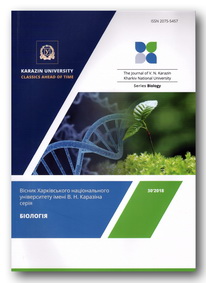Induction of bystander effect in root meristem of soybean seedlings after γ-irradiation
Abstract
The bystander effect refers to the non-target effects of ionizing radiation and it is the occurrence of radiation damages in the cells that have not been exposed to direct action of ionizing radiation. The aim of the study is to investigate the possibility of forming the “bystander effect” during the germination of irradiated and intact seeds of some soybean Glycine max (L.) Mer. varieties in the common aquatic environment. The soybean seeds of the Raiduga and Sprytna varieties (obtained by selection) and the genetically modified Apollo variety had been exposed to γ-radiation at a dose of 40 Gy. The mitotic activity of the seedlings root meristem cells of irradiated (IR) and intact (IN) seeds, as well as intact seeds, which were germinated in the same aqueous medium together with irradiated (INIR), was analyzed. The similar levels of mitotic activity were observed in seedlings of breeding varieties in “IN” variant, while cells in genetically modified variety divided more intensively. Radiation exposure in a dose of 40 Gy increased the level of mitotic activity in all varieties. The values of the mitotic indices increased 2 times in the varieties of Raiduga and Sprytna. The increase in Apollo variety was less significant, but this may be due to a high level of mitotic activity in the control variant. Irradiation also contributed to the appearance of chromosomal aberrations: fragments and bridges. The increase in mitotic activity in the meristem of the studied varieties to the mentioned levels may indicate the presence of a pool of meristem cells that can accelerate the passage of phases of the mitotic cycle under extreme conditions. Mitotic activity increased in the “INIR” variant in all investigated varieties. The largest excess over the “IN” was in Sprytna, a little less in the variety Raiduga. The proliferative activity in the Apollo variety meristem remained almost unchanged. Thus, the work shows the possibility of a “bystander effect” forming under the condition of joint germination of irradiated and intact seeds in the common aquatic environment. The intensity of “bystander effect” formation depends on the genotype and start mitotic potential.
Downloads
References
Атраментова Л.О., Утєвська О.М. Статистичні методи в біології. – Х.: ХНУ імені В.Н. Каразіна, 2007. – 288с. /Atramentova L.O., Utevska O.M. Statistical methods in biology. – Kharkiv: V.N.Karazin Kharkiv National University, 2007. – 288p./
Гудков И.Н. Радиационная стимуляция растений // Материалы Международной научно-практической конференции «Микроэлементы и регуляторы роста в питании растений: теоретические и практические аспекты». – Ульяновск, 2014. – С.27. /Gudkov I.N. Radiation stimulation in plants // Materials of the International scientific-practical conference "Microelements and growth regulators in plant nutrition: theoretical and practical aspects." – Ulyanovsk, 2014. – P.27./
Котеров А.Н. Перспективы учета «Эффекта свидетеля» при оценке радиационных рисков // Медико-биологические проблемы жизнедеятельности. – 2011. – №1 (5). – С. 7–19. /Koterov A.N. Prospects for taking into account the “Bystander effect” in assessing radiation risks // Biomedical Problems of Life. – 2011. – No.1 (5). – P. 7–19./
Кравец А.П., Венгжен Г.С., Гродзинский Д.М. Эффекты дистанционного взаимодействия облученных и необлученных растений // Радиационная биология. Радиоэкология. – 2009. – Т.49, №4. – С. 490–494. /Kravets A.P., Wengzhen G.S., Grodzinsky D.M. Effects of the remote interaction of irradiated and unirradiated plants // Radiation Biology. Radioecology. – 2009. – Vol.49, no.4. – P. 490–494./
Шеметун О.В., Пілінська М.А. Радіаційно-індукований «ефект свідка» // Цитология и генетика. – 2007. – Т.41, №4. – С. 66–71. /Shemetun O.V., Pіlіnska M.A. Radiation-induction "bystander effect" // Cytology and Genetics. – 2007. – Vol.41, no.4. – P. 66–71./
Karthik K., Vasumathy R., Badri N.Pandey et al. Primary and secondary bystander effect and genomic instability in cells exposed to high and low linear energy transfer radiations // International Journal of Radiation Biology. – 2019. – Published online: 09/17/2019.
Marin A., Martin M., Linan O. et al. Bystander effects and radiotherapy // Rep. Pract. Oncol. Radiother. –2015. – Vol.20 (1). – P. 12–21.
Mothersill C., Seymour C. Relevance of radiation-induced bystander effects for environmental risk assessment // Radiats. Biol. Radioecol. – 2002. – Vol.42, no.6. – P. 585–587.
Mothersill C., Rusin A., Seymour C. Relevance of non-targeted effects for radiotherapy and diagnostic radiology: a historical and conceptual analysis of key players // Cancers (Basel). – 2019. – Vol.11 (9). – pii: E1236.
Rozhko T.V., Nogovitsyna E.I., Badun G.A. et al. Reactive oxygen species and low-dose effects of tritium on bacterial cells // Journal of Environmental Radioactivity. – 2019. – Vol.208–209. – Article 106035.
Verma N., Tiku A.B. Significance and nature of bystander responses induced by various agents // Mutation Research/Reviews in Mutation Research. – 2017. – Vol.773. – P. 104–121.
Widela M., Lalika A., Krzywona A. et al. The different radiation response and radiation-induced bystander effects in colorectal carcinoma cells differing in p53 status // Mutation Research/Fundamental and Molecular Mechanisms of Mutagenesis. – 2015. – Vol.778. – P. 61–70.
Authors retain copyright of their work and grant the journal the right of its first publication under the terms of the Creative Commons Attribution License 4.0 International (CC BY 4.0), that allows others to share the work with an acknowledgement of the work's authorship.




